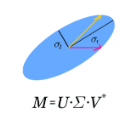We study the problem of estimating a large, low-rank matrix corrupted by additive noise of unknown covariance, assuming one has access to additional side information in the form of noise-only measurements. We study the Whiten-Shrink-reColor (WSC) workflow, where a "noise covariance whitening" transformation is applied to the observations, followed by appropriate singular value shrinkage and a "noise covariance re-coloring" transformation. We show that under the mean square error loss, a unique, asymptotically optimal shrinkage nonlinearity exists for the WSC denoising workflow, and calculate it in closed form. To this end, we calculate the asymptotic eigenvector rotation of the random spiked F-matrix ensemble, a result which may be of independent interest. With sufficiently many pure-noise measurements, our optimally-tuned WSC denoising workflow outperforms, in mean square error, matrix denoising algorithms based on optimal singular value shrinkage which do not make similar use of noise-only side information; numerical experiments show that our procedure's relative performance is particularly strong in challenging statistical settings with high dimensionality and large degree of heteroscedasticity.
翻译:我们研究如何估计一个大而低位的矩阵,它被未知共差的添加性噪音所腐蚀,假设一个人能够以仅噪音测量的形式获得更多的侧边信息。我们研究白-Shrink-ReColor(WSC)工作流程,该流程将“新奇共差白化”转换应用于观测中,然后是适当的单值缩水和“新奇共差变色”变色。我们发现,在中正方错误损失下,WSC解密工作流程存在一种独特的、非现性最佳的缩水非线性缩水算法,并以封闭的形式计算。我们为此计算随机加注的F-matric 共差(WSC)流程的无线性静脉动。如果测量结果足够纯正方差,我们最优化地调整WSC脱色工作流程外形,在中正方错误中,基于最佳单值缩水缩水算法的矩阵脱色算法,而不会同样地使用噪声的侧信息。我们的数字实验显示,在高度的统计学度上,我们的程序具有很强的挑战性。



